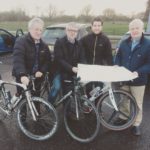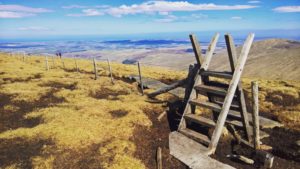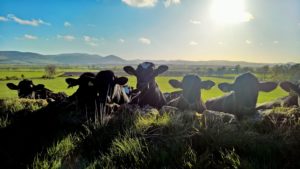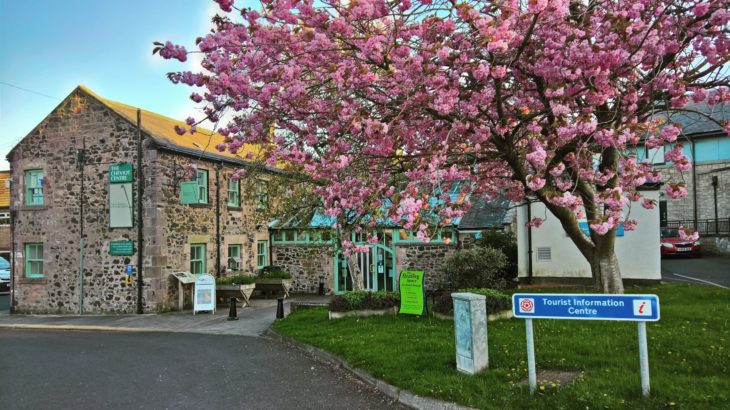 My first five weeks in Wooler were up on April 23rd. From this Monday on, I’m starting to count the days that I have left and not the days I’ve been in this delightful, vibrant place. Not having been able to publish more articles since April 15th has been weighing more heavily on my shoulders with every day that goes by. For all those who thought that I was just taking some holidays at the expense of the German state … I’m sorry to disappoint you. In this town, there are simply too many things going on and you cannot help but get involved in them. And that is why I have little time left to do any writing!
My first five weeks in Wooler were up on April 23rd. From this Monday on, I’m starting to count the days that I have left and not the days I’ve been in this delightful, vibrant place. Not having been able to publish more articles since April 15th has been weighing more heavily on my shoulders with every day that goes by. For all those who thought that I was just taking some holidays at the expense of the German state … I’m sorry to disappoint you. In this town, there are simply too many things going on and you cannot help but get involved in them. And that is why I have little time left to do any writing!
Fortunately, as every good researcher should do, I make notes on a continuous basis in a field journal. Reading over it is the way I can remember in detail many of the things that have happened during these first five weeks.
Thanks for their efforts to all those people who have collaborated – I have managed to obtain a total of 185 responses to my questionnaire to assess the resilience of the village and its surroundings. The way the locals have participated is fantastic!
I have also already done about 10 interviews and I have another 10 or 15 to go. Now I have to get busy on the evaluation to present and discuss the preliminary results in a public presentation this coming May 24th (5:30 pm) at the Cheviot Centre community centre.
 Together with the Glendale Gateway Trust I am working within the framework of the “Twin Towns UK” initiative promoted by the Carnegie UK Trust to develop a digital marketing strategy to relaunch Wooler and Glendale to the 21st century of digital technologies. We are also preparing a survey for tourists and visitors that will be ready in the coming weeks. In the context of the Carnegie UK-initiative, I was able to travel to Northern Ireland at the beginning of April to get to know Wooler’s sister town of Broughshane at first hand. From there we brought back, especially, the pragmatism and assertiveness with which the local representatives and the civil society in Broughshane face up to the challenges connected with promoting a more vibrant and dynamic town.
Together with the Glendale Gateway Trust I am working within the framework of the “Twin Towns UK” initiative promoted by the Carnegie UK Trust to develop a digital marketing strategy to relaunch Wooler and Glendale to the 21st century of digital technologies. We are also preparing a survey for tourists and visitors that will be ready in the coming weeks. In the context of the Carnegie UK-initiative, I was able to travel to Northern Ireland at the beginning of April to get to know Wooler’s sister town of Broughshane at first hand. From there we brought back, especially, the pragmatism and assertiveness with which the local representatives and the civil society in Broughshane face up to the challenges connected with promoting a more vibrant and dynamic town.  By the way, Broughshane was recently elected “UK Village of the Year 2018” for the dynamism of its community and the strong social movement working for the renovation and floral decoration of the town. If you are travelling around Northern Ireland, don’t miss it!
By the way, Broughshane was recently elected “UK Village of the Year 2018” for the dynamism of its community and the strong social movement working for the renovation and floral decoration of the town. If you are travelling around Northern Ireland, don’t miss it!
Remember that in my first post I posed the question of whether Wooler would be a resilient town? Trying to come up with an answer to this question is the starting point for my doctoral project. Obviously, I do not have a definitive answer, but through my first interviews, little by little, some key ideas from my stay here are beginning to take shape. The following paragraphs give you some more details.
 Both for people who have moved to the village, as well as for many of those who have lived in the region since they were born, the natural beauty of Glendale and the Cheviot Hills is a very important reason to live here. They have the tranquillity and the majesty of the countryside round about very much in mind when it comes to assessing their quality of life. This affects what I described in the first post as “sense of place” and which contributes decisively to something as human as “identity” – where do I come from? where am I? where am I going? Identity and the sense of belonging to a place and a community are important bases for collective action and for confronting challenges that emerge.
Both for people who have moved to the village, as well as for many of those who have lived in the region since they were born, the natural beauty of Glendale and the Cheviot Hills is a very important reason to live here. They have the tranquillity and the majesty of the countryside round about very much in mind when it comes to assessing their quality of life. This affects what I described in the first post as “sense of place” and which contributes decisively to something as human as “identity” – where do I come from? where am I? where am I going? Identity and the sense of belonging to a place and a community are important bases for collective action and for confronting challenges that emerge.
Many of the people I have spoken to attribute a certain degree of wilfulness, to the locals resulting from the difficult living conditions in the past when the region was even more isolated than it is now (this argument is also used in academic circles to explain, and even in some cases justify, the so-called self-help culture). Furthermore, being a border region characterised by constant warlike conflicts, changes of political dominion, as well as by more than 400 years of skirmishes between border raiders and reivers and the inhabitants settled in the region, the local people have developed a notable degree of independence of action and self-sufficiency.
There also seems to be an honesty and a way of being very frank and communicative that can sometimes take visitors or newcomers aback.
This openness is usually an important asset when it comes to integrating new people into local groups and associations, which I still continue to consider as very diverse and key to the integration of a wide range of interests and personalities.  On rare occasions, this direct manner and the interest locals show in visitors and new residents (in many cases retired people from urban areas who move in search of the natural beauty and tranquillity described above) is perceived as “meddling”, when in fact it is an expression of the interest and healthy concern that rural residents show for their closest neighbours. After all, they both share the material conditions of life more closely and interdependently than in the city. Anonymity is not valued in villages. As one interviewee aptly put it to me: “In our rural environment, due to the lower population density, someone is not just a postman, a baker or a doctor – here you are THE postman, THE baker or THE doctor and the consequences of ceasing to be that figure immediately affect the people around you”. Empathy or privacy, interest or being nosey? – Different perceptions that can occur in rural areas.
On rare occasions, this direct manner and the interest locals show in visitors and new residents (in many cases retired people from urban areas who move in search of the natural beauty and tranquillity described above) is perceived as “meddling”, when in fact it is an expression of the interest and healthy concern that rural residents show for their closest neighbours. After all, they both share the material conditions of life more closely and interdependently than in the city. Anonymity is not valued in villages. As one interviewee aptly put it to me: “In our rural environment, due to the lower population density, someone is not just a postman, a baker or a doctor – here you are THE postman, THE baker or THE doctor and the consequences of ceasing to be that figure immediately affect the people around you”. Empathy or privacy, interest or being nosey? – Different perceptions that can occur in rural areas.
 Again, the geographical situation and the way the place is communicated, are, in my opinion, crucial for the vitality of a place the size of Wooler. Despite being unquestionably a peripheral location, we must not lose sight of the fact that the main road connecting the village takes people to Newcastle (1 hour by car) and Edinburgh (1hr 40m by car). On the other hand, the medium-sized towns that serve as a reference (for shopping and more specific services), Alnwick and Berwick upon Tweed are about 35 minutes away by car which to a certain extent prevents people in the area always going outside Wooler to do their errands and shopping. From Monday to Saturday, there are acceptable bus connections considering it is such a sparsely populated area. Many locals won’t agree with this, but from a “continent-perspective” the bus service is really not bad.
Again, the geographical situation and the way the place is communicated, are, in my opinion, crucial for the vitality of a place the size of Wooler. Despite being unquestionably a peripheral location, we must not lose sight of the fact that the main road connecting the village takes people to Newcastle (1 hour by car) and Edinburgh (1hr 40m by car). On the other hand, the medium-sized towns that serve as a reference (for shopping and more specific services), Alnwick and Berwick upon Tweed are about 35 minutes away by car which to a certain extent prevents people in the area always going outside Wooler to do their errands and shopping. From Monday to Saturday, there are acceptable bus connections considering it is such a sparsely populated area. Many locals won’t agree with this, but from a “continent-perspective” the bus service is really not bad.
Finally I need to mention a curious feature of this region (in this case Glendale is my basic unit of reference) regarding employment.
With 14% of the working population employed in agriculture, livestock and forestry – an extremely high percentage within the general European context and comparable to countries such as Poland or Greece – this sector is still of great importance.
 It has direct effects (farmers, their families and their employees) and numerous indirect effects (processing of agricultural products and short distribution chains, services to agriculture such as fencing, mechanical and agricultural engineering, etc.). However, it is very difficult to get young people in the area to work in the vacancies that become available in the sector because due to the high level of mechanization and the lack of structured training and professional qualifications, the only jobs available are the hardest and least attractive ones. There is work, but a lot of the potential of local youngsters is attracted by the promise of higher education and better incomes in the large population centres. The question of how to offer prospects to these “sons and daughters” of the area is a titanic task to which a rural community on its own can only contribute to a limited extent. Complementary measures “from the top” are necessary. Measures, which have an impact on the education system and regulate the labour market.
It has direct effects (farmers, their families and their employees) and numerous indirect effects (processing of agricultural products and short distribution chains, services to agriculture such as fencing, mechanical and agricultural engineering, etc.). However, it is very difficult to get young people in the area to work in the vacancies that become available in the sector because due to the high level of mechanization and the lack of structured training and professional qualifications, the only jobs available are the hardest and least attractive ones. There is work, but a lot of the potential of local youngsters is attracted by the promise of higher education and better incomes in the large population centres. The question of how to offer prospects to these “sons and daughters” of the area is a titanic task to which a rural community on its own can only contribute to a limited extent. Complementary measures “from the top” are necessary. Measures, which have an impact on the education system and regulate the labour market.
With these ideas, I’ll leave you pondering … Until the next post!
